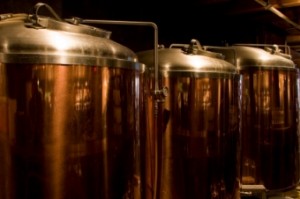Washing yeast to reuse it in another batch of beer is a great technique to have in your home brewing arsenal. Yeast washing is a simple process used to separate the live yeast from the underlying trub (hops and spent grains) left at the bottom of your fermenter when making beer.
With the high price of hops and malt, yeast washing is a great way to save a few dollars and also build a strong yeast culture as a basis for a yeast starter. Rather than purchase new yeast each time you can wash and reuse your yeast across as many as 5-6 batches spread out over a period of months by reusing yeast from your primary fermentation.
Yeast washing is remarkably easy to do, involves minimum equipment and can be done in a short period of time. All that is required is two sanitized mason jars, some distilled or pre-boiled sanitized water and some plastic or foil to put over the jars. Sanitizing or sterilizing everything involved is critically important as yeast is susceptible to infection.
Washing your Yeast
Start by sterilizing your two jars by boiling them in water or immersing them in a high quality sanitizing solution. Prepare a few quarts of sterile water by pre-boiling it and then cooling it to room temperature. Use sanitizing solution such as iodophor to sanitize the rim of your fermenter.
If possible, you want to draw your yeast sample from the primary fermenter as it contains more active yeast than the secondary. Harvest the yeast immediately after racking your beer off to the secondary, as you want to minimize the chance of contamination. The primary will contain a layer of thick trub. You need a bit of liquid to work with, so add a quart of sterile water to the primary if needed.
Swish the fermenter around several times to break up the trub and then allow it to settle for a few minutes. Pour the liquid from the top of the trub into one of your mason jars, being careful to keep everything as sterile as possible.
After collecting your yeast and trub put some foil or plastic wrap over the top and seal it with a rubber band. Put the mason jar in your refrigerator for 30-60 minutes which will help it separate. Ideally you will see a clear separation between the liquid and sediment. The liquid contains suspended yeast, while the sediment is primarily trub.
The next step is simply to pour off the liquid suspended yeast from the top of your mason jar leaving as much of the sediment behind as possible. Pour your yeast into a second mason jar, cover it and place it in the fridge again for an hour or so. The purpose here is simply to separate the heavy sediment.
If you still have a significant amount of trub at the bottom of the second mason jar, you may want to consider mixing in some sterile water and washing the yeast again. If not, you can store the yeast for several months in the refrigerator until you are ready to brew again. If you plan to store it for an extended period you may want to consider transferring it to a flask or bottle with an airlock and keep it in the refrigerator to prevent contamination.
Over a period of several weeks the yeast itself will settle to the bottom and this yeast is the portion you need to create a starter for your next batch of beer.
On the day before you brew, add some wort to your yeast create an appropriately sized yeast starter for your next batch. If you want to use your yeast across several batches you can either split your starter and store part of it for later use or repeat the entire process to collect yeast from the primary again.
If you do collect yeast across several generations, I recommend not exceeding 4-6 generations of reuse as eventually some wild yeasts or bacteria will make there way into your yeast.
Washing your yeast is a great way to save a few dollars while keeping a healthy supply of fresh yeast available for your favorite brew. Thanks again for visiting the BeerSmith Blog. As always, your subscriptions, comments and social bookmarks are appreciated.
Related Beer Brewing Articles from BeerSmith:
- Should you use a Secondary for Beer Brewing?
- My Love-Hate Relationship with Home Brew Beer Siphoning
- Conical Fermenter Advantages for Home Brewing
- Cleaning and Sanitation for Beer Brewing
- Six Tips for Minimizing Beer Brewing Losses
- Dry Yeast in Home Brewed Beer
- Storing Your Beer Brewing Hops, Grains and Yeast
- Bottling Beer: 10 Tips for Home Brewers
Don't make another bad batch of beer! Give BeerSmith a try - you'll brew your best beer ever.
Download a free 21 day trial of BeerSmith now




{ 2 comments… read them below or add one }
← Previous Comments
Really interesting article. How long will the salvaged yeast last for and how should it be stored to maximise its life and effectiveness? I quite often prime my yeast with some Malt extract if I have any or a sugar like Muscovado. It usually seems to work for me.
When creating a yeast starter from harvested yeast, how do you calculate (or approximate) how much to use? Do you measure a volume of yeast cake? If so, is there a rule of thumb for number of yeast cells per ounce or tablespoon or mL of yeast cake? Is there also a rule of thumb for viability degradation of that yeast cake per week or month of storage in the refrigerator?